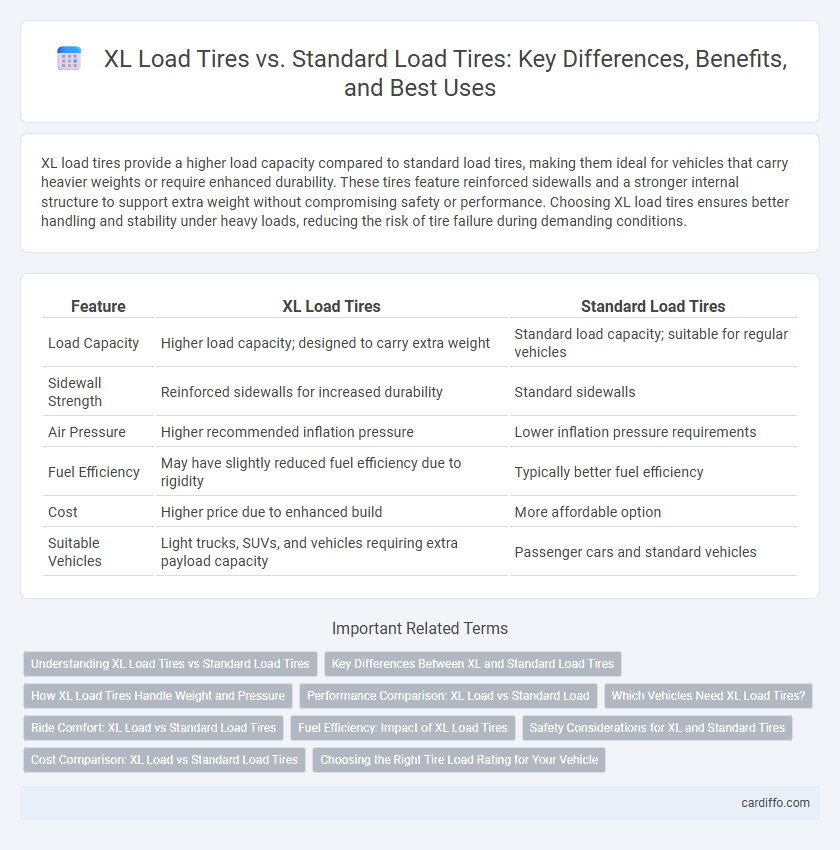XL load tires provide a higher load capacity compared to standard load tires, making them ideal for vehicles that carry heavier weights or require enhanced durability. These tires feature reinforced sidewalls and a stronger internal structure to support extra weight without compromising safety or performance. Choosing XL load tires ensures better handling and stability under heavy loads, reducing the risk of tire failure during demanding conditions.
Table of Comparison
| Feature | XL Load Tires | Standard Load Tires |
|---|---|---|
| Load Capacity | Higher load capacity; designed to carry extra weight | Standard load capacity; suitable for regular vehicles |
| Sidewall Strength | Reinforced sidewalls for increased durability | Standard sidewalls |
| Air Pressure | Higher recommended inflation pressure | Lower inflation pressure requirements |
| Fuel Efficiency | May have slightly reduced fuel efficiency due to rigidity | Typically better fuel efficiency |
| Cost | Higher price due to enhanced build | More affordable option |
| Suitable Vehicles | Light trucks, SUVs, and vehicles requiring extra payload capacity | Passenger cars and standard vehicles |
Understanding XL Load Tires vs Standard Load Tires
XL load tires, also known as Extra Load tires, are engineered to carry higher air pressure and support increased load capacities compared to Standard load tires, making them ideal for heavier vehicles or those frequently carrying heavy cargo. These tires have reinforced sidewalls and stronger internal construction, enhancing durability and performance under stress. Selecting XL load tires ensures improved safety and tire longevity when exceeding the weight limits of Standard load tires.
Key Differences Between XL and Standard Load Tires
XL load tires feature reinforced sidewalls and higher load capacity ratings compared to standard load tires, allowing them to support heavier vehicles and increased pressure levels. Standard load tires are designed for everyday passenger vehicles with lower maximum load and inflation pressure limits. The key difference lies in XL tires' enhanced structural strength and durability, which provide improved safety and performance when carrying additional weight.
How XL Load Tires Handle Weight and Pressure
XL load tires, designed with reinforced sidewalls and increased ply ratings, manage higher weight and pressure compared to standard load tires, ensuring enhanced durability and stability under heavy loads. These tires maintain optimal air pressure over extended periods, reducing the risk of blowouts and improving overall tire performance for vehicles carrying extra weight. Their construction enables better heat dissipation, which is critical for preserving tire integrity during sustained heavy-duty use.
Performance Comparison: XL Load vs Standard Load
XL load tires offer enhanced load-carrying capacity compared to standard load tires, allowing vehicles to support heavier weights without compromising tire integrity. Their reinforced sidewalls provide better resistance to heat buildup and deformation, resulting in improved durability and safety under high-load conditions. Standard load tires may perform adequately under normal circumstances but lack the structural robustness needed for heavy-duty applications, leading to faster wear and reduced performance.
Which Vehicles Need XL Load Tires?
XL load tires are designed for vehicles that carry heavier loads or require higher inflation pressures, such as SUVs, pickup trucks, and commercial vans. These tires have reinforced sidewalls to support additional weight compared to standard load tires, making them essential for vehicles frequently hauling heavy cargo or towing. Choosing XL load tires ensures optimal safety, performance, and tire longevity under increased load conditions.
Ride Comfort: XL Load vs Standard Load Tires
XL load tires, designed for higher load capacity, typically have stiffer sidewalls, which can result in a firmer and less comfortable ride compared to standard load tires. Standard load tires offer more flexibility and cushioning, enhancing ride comfort by absorbing road vibrations better. Choosing between XL and standard load tires involves balancing load requirements with desired ride smoothness.
Fuel Efficiency: Impact of XL Load Tires
XL load tires, designed to carry heavier loads, typically have reinforced sidewalls that increase rolling resistance compared to standard load tires. This elevated rolling resistance can result in slightly reduced fuel efficiency, as engines must work harder to maintain speed. Despite the minor fuel consumption increase, XL tires provide improved durability and safety for heavier vehicles, making them essential for specific load requirements.
Safety Considerations for XL and Standard Tires
XL load tires, designed with reinforced sidewalls, provide enhanced stability and load-bearing capacity, significantly reducing the risk of tire failure under heavy loads. Standard load tires, while suitable for regular driving conditions, may experience increased heat buildup and wear when overloaded, leading to potential blowouts and compromised safety. Choosing XL load tires for vehicles carrying heavier loads ensures better traction, improved handling, and a safer driving experience by maintaining optimal tire pressure and structural integrity.
Cost Comparison: XL Load vs Standard Load Tires
XL load tires typically cost 20-30% more than standard load tires due to reinforced construction and higher load capacity ratings. The initial investment in XL load tires is offset by increased durability and reduced replacement frequency under heavy load conditions. Standard load tires offer lower upfront costs but may incur higher long-term expenses from more frequent wear and potential load-related damage.
Choosing the Right Tire Load Rating for Your Vehicle
Selecting the appropriate tire load rating is crucial for vehicle safety and performance, where XL (Extra Load) tires offer higher load capacity compared to Standard Load tires, making them suitable for heavier vehicles or those carrying additional weight. XL tires typically have reinforced sidewalls and higher inflation pressures, enhancing durability and handling under greater stress. Ensuring tire load rating matches or exceeds the vehicle manufacturer's specifications prevents premature wear, improves fuel efficiency, and maintains optimal traction.
XL load tires vs Standard load tires Infographic

 cardiffo.com
cardiffo.com